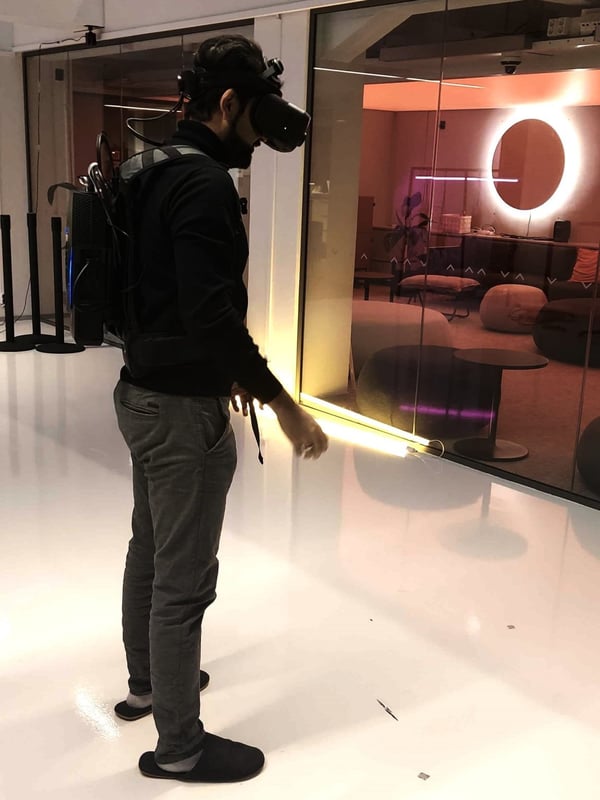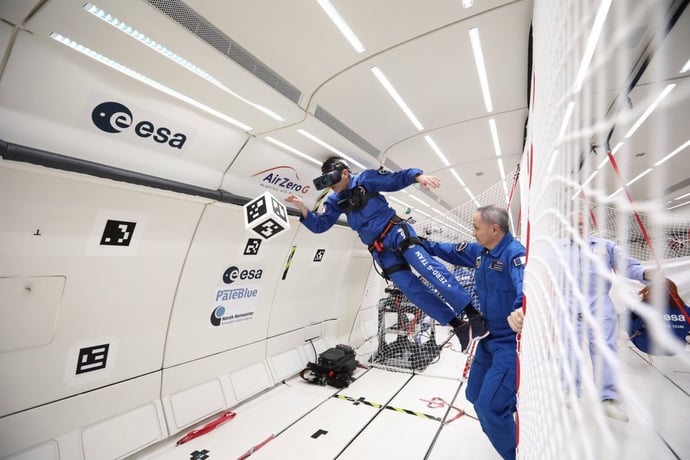Backpack PCs for VR and XR
Extended reality technologies are advancing by leaps and bounds. While graphics have substantially improved in the past few years on both tethered and untethered devices alike, one thing has remained constant: to reach the highest visual quality available, a VR/XR headset still requires tethering to a PC.
Effectively this means that the highest-end virtual and mixed reality experiences have not been available for scenarios where portability is required. However, there have been some developments on the PC hardware front lately, which allow some degree of portability – even with professional-grade devices, such as Varjo headsets.
PCs Come in Many Shapes and Sizes
While you obviously can’t lug around a desktop computer in most cases, more powerful laptops can be used to run highest-immersion VR/XR to some extent.
Even when using a laptop, you still typically end up placing it on a table and moving around tethered while the computer remains stationary. While this does get you closer to the point of need, you are still reliant on the length of the cable from the laptop. Stuffing the laptop into a backpack is unlikely to work either, as you then start running into issues with cooling and air intake.
This is where backpack computers come in handy. While they can’t fully replace a powerful desktop PC, the high-end models are starting to reach a level of battery life and processing power where high-end VR and XR can be run in a meaningful way.

Benefits of Backpack Computers
While you still can’t fully cut the cord with a backpack computer, you get a meaningful increase in mobility and remove the dependency on cable length. Another major benefit is that backpack PCs can make many multi-user scenarios in the same shared physical space much more comfortable. For example, you no longer run into issues with each user having their own cables running on the floor, risking collaborators getting entangled in them.
Backpack computers also have a better power output than most laptops (especially when the laptop is not connected to a power outlet), so they can power the headset itself without an additional power supply, something most laptops will struggle with.
But what kind of hardware do you require for this to work? At Varjo, we’ve successfully run our headsets with the Zotac VR GO 4.0 VR backpack PC. It allows for excellent visual quality and has a battery life of 45-60 minutes when running the most workload-intensive VR and XR applications, which is usually sufficient for most scenarios. Luckily, most backpack computers also allow hot-swapping of batteries while the computer runs, so this can easily be extended to longer durations if needed.
Thanks to backpack computers, many use cases where visual quality is important can be improved and new ones introduced.
Enabling New Use Cases and Improving Existing Ones
Here are just a few examples of use cases where backpack computers can make sense.

Design Reviews
Design reviews are one of the most common use cases for Varjo headsets. While they work great with remote participants joining a session, using multiple headsets in the same physical space can sometimes be challenging if the physically co-located design team members want to move around extensively.
As people enjoy seeing the real world and collaborating in person (not just remotely), backpack computers can better the sessions. With a backpack computer, it is easier to move around the digital model in a group and discuss the design in detail from all angles. A typical review session can easily be completed in an hour, meaning the battery life is not a blocker.
Group Training
When done properly, immersive training can be extremely effective. Some training scenarios (such as flight simulation) can be run easily when the trainee is stationary. However, other training scenarios require moving around in a larger area and benefit hugely from added portability, especially when done in a group setting.
A great practical example is power plant control room training, where people operate in shifts with a team. Thanks to backpack computers, highly immersive training sessions can be run for groups of people so they can practice operating together just as they would in a physical control room.
Manufacturing Teams
Production engineering work can already be carried out effectively with tethered devices. However, added portability can help bring headsets closer to the point of use, which enables additional use cases. For example, when you are planning changes to an assembly line or installing new machinery, it may be valuable to see the actual physical space where these changes are to be made.
When you are able to overlay the digital model on top of the real space, it provides you with deeper insights than a 2D diagram, making clash detection and discovering other potential problems (such as if a new robot arm could potentially get in the way of workers) easier.
Architecture
Another potential use case for this added portability is high-resolution architecture and construction. While architectural models can easily be moved around a user sitting stationary at a desktop computer, the ability to move around could prove useful.
For example, a team of architects can move around inside a digital model rendered on a real-life scale. Interior designers could show someone different alternatives to the decor while enabling them to move around the entire space. This could work well for both consumer use cases (e.g. selling new apartments) and business use as well (e.g. showing interior options for an office building or a cruise ship).
In conclusion
Backpack computers can go a long way in improving portability in some VR/XR scenarios.
Until the technology matures to the point where the highest-end virtual content can be shown using untethered devices, these portability improvements can be a very useful intermediate solution.
If you are considering a use case where high visual quality and the ability to move around are both required, Varjo headsets with backpack computers may well solve the challenge.
Want to learn more about using Varjo’s XR/VR with a backpack PC? Schedule a call with our sales experts.


